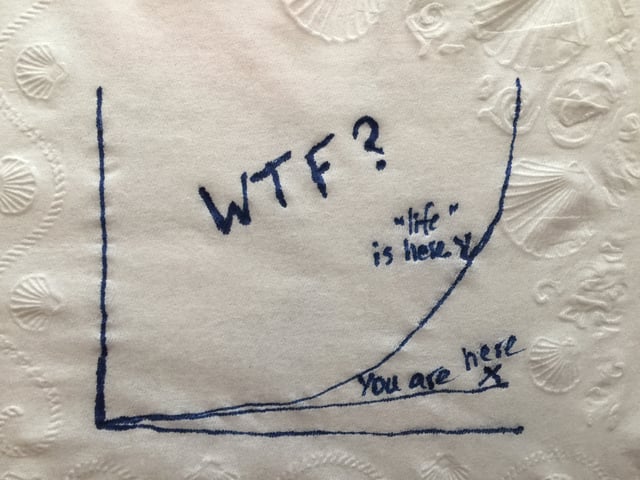Building a Next-Gen Platform for New Producers and Consumers in the Cybersecurity Industry.
In 2012, I sensed the Internet’s “democratization” effect was reaching cyber risk, such that a massive increase in cyber crime was not far away....

Does it feel things are changing faster than ever before? Well, they are. For the past 50 years, the pace of change in everyday life has been accelerating, driven by the powerful forces of digital technology. But, what's especially interesting is that it's just the tip of what is to come. Massive change lays ahead and the pace of change that we will experience in our daily lives, much less in that of our children, will be unlike anything humanity has seen before. Fortunately, understanding some basic fundamentals of what drives digital technology explains not only how we got to where we are now, but provides focus for what change will look like tomorrow and provides a framework from which to prepare for a future very different from today. Here, we explore this framework and how to apply optimally and leverage it in life; personal and professional, virtual and real.

If there is a single, most important concept to understand and one that applies to all things in the Digital Age, it is most certainly the power of exponential math. Grasping exponentials provides the foundation of a framework required to:
If you understand exponentials, the key to many of the secrets of the universe is in your hand." - Carl Sagan
The term "exponential", especially how we apply it here, refers to rates of change that when compounded and experienced regularly, can advance even off a small base to rapidly achieve tremendous scale and overwhelm everything that stood before it. After an eternity living in a linear world, it is supremely difficult for humans to comprehend fully the power of exponential progression. Now, not only is comprehension essential but today an application of the understanding is required for mere survival, much less performance.
To keep it simple, but still express the profound insight gained by grasping exponential math, we use a single quote by Ray Kurzweil, Director of Engineering at Google and who, with a 30-year track record of accurate predictions, is long considered one of the world’s leading inventors, thinkers, and futurists.
Our intuition about the future is linear. But the reality of information technology is exponential, and that makes a profound difference. If I take 30 steps linearly, I get to 30. If I take 30 steps exponentially, I get to a billion.
We use this graph to illustrate Kurzweil's multi-faceted point:

Spend a moment pondering Kurzweil's example of the math; from 1 to a billion in a mere 30 steps. The powerful math of exponentials is the underpinning for the framework required to face the pace of change while living successfully in the Digital Age.
#1 - The last 50 years, and why it defines the new Digital Age for humanity.
For a real-world application of exponentials and the profound impact they have had for the last half-century, we turn to Moore's Law.
50 years ago Gordon Moore, one the inventors of the microprocessor and co-founder of Intel, observed that production performance of the computer chip doubled every two years, and manufacturing price halved over the same period, or so. By now you know the rate of progress (change) Moore observed is exponential. Moore got it right because his observation was rooted in the natural reality inherent in the physics of information technology, and his pronouncement marked the dawn of the Digital Age.
 In just five decades, entire new industries and vast fortunes were created by those that could comprehend and apply Moore's Law. Others, those that underestimated the power of exponentials and insufficiently applied the new framework for change were left with little if anything at all. Think about the changes in long distance calls (ATT vs. Skype), photography (Kodak vs. Instagram) the music industry (record stores vs. iTunes), retail (local stores vs. eBay and Amazon), transportation (Yellow Cab vs. Uber), lodging (Marriott vs. AirBnB) and newspapers (Twitter), and so on. Volumes have been written on the subject, and you can find more in a succinct article at The Economist, but the point is clear; comprehending the power of exponential change and how it applies to life in the Digital Age is essential.
In just five decades, entire new industries and vast fortunes were created by those that could comprehend and apply Moore's Law. Others, those that underestimated the power of exponentials and insufficiently applied the new framework for change were left with little if anything at all. Think about the changes in long distance calls (ATT vs. Skype), photography (Kodak vs. Instagram) the music industry (record stores vs. iTunes), retail (local stores vs. eBay and Amazon), transportation (Yellow Cab vs. Uber), lodging (Marriott vs. AirBnB) and newspapers (Twitter), and so on. Volumes have been written on the subject, and you can find more in a succinct article at The Economist, but the point is clear; comprehending the power of exponential change and how it applies to life in the Digital Age is essential.
Even Moore himself was surprised by the accuracy of his observation and its consistency of recurrence over time, but it is in the accuracy and consistency of the phenomenon that holds the answers we seek. The future of digital technology is uniquely predictable in terms of performance and price, and it's this inherent value proposition that lies at the root of almost everything we sense as "change" today. Consider Moore's Law the application of exponentials that demonstrates the force that transformed society in only 50 years time, and as a relevant record of the past in order to better understand today and optimally position one's self for tomorrow.
#2 - Perceiving realistically what is happening today and why it marks the next stage of unprecedented change.
After 50 years of compounding at exponential rates of progress, we are at the hockey-stick part of the curve as it applies to digital technology and its impact on the human experience. Take Kurzweil's example of doubling 1 just 30 times to reach a billion. Well, the 31st step is 2 billion, and the 32nd 4 billion, and you see the point - the slope of change is going parabolic.
Ancient wisdom has long defined change as a field fertile for both risk and opportunity. Never have they been so right, or their wisdom applied more profoundly than today. Considering today's pace of change, and the accelerating rate of change in our immediate future, managing and leveraging change has become the primary component to survival and success.
After half a century, digital technology has risen from the scientific laboratories of academia and commerce to now include most all of that which defines the fabric of one's life. Change in our every day experience is now defined by the exponential properties of digital technology and the disconnect with our linear, human nature, is widening and creating profound implications.
The "delta" between our linear intuition and the actuality of what is happening around us is diverging all of the time. Where intellect fails, imagination fills, and apathy has suddenly become the #1 destructive, killer force of the future.
“The greatest shortcoming of the human race is our inability to understand the exponential function.”
― Albert A. Bartlett, Emeritus professor of physics at the University of Colorado, Boulder
#3 - Accurately predicting the changes to come.
Extrapolating the now proven predictable laws that drive digital technology and applying them for a view into the future is not only advisable but now required for optimal performance in everything we do. Fortunately, it is rather easy as we have the math, and it can be distilled to:
Call it BEFC. Better, easier, faster, and cheaper describes the future of digital technology and the rate at which it gets there progresses exponentially, i.e. faster all the time. The tricky part is guessing what it means. We can describe the technology of the future in a highly accurate fashion but what does it mean to society, to business, or most importantly, to you and your family? That question is to be looked at below, in #4, but in the interim, let's go back to Kurzweil, the best prognosticator of these things on the planet.
In less than five years and by 2019 we can expect:
![]() Computers are embedded everywhere in the environment (inside of furniture, jewelry, walls, clothing, etc.). (Kurzweil's reference here is known as the IoT, or Internet of Things and it represents the embodiment of the next stage to the Digital Age.
Computers are embedded everywhere in the environment (inside of furniture, jewelry, walls, clothing, etc.). (Kurzweil's reference here is known as the IoT, or Internet of Things and it represents the embodiment of the next stage to the Digital Age.
![]() Household robots are ubiquitous and reliable.
Household robots are ubiquitous and reliable.
![]() Most roads now have automated driving systems—networks of monitoring and communication devices that allow computer-controlled automobiles to safely navigate.
Most roads now have automated driving systems—networks of monitoring and communication devices that allow computer-controlled automobiles to safely navigate.
![]() People experience 3-D virtual reality through glasses and contact lenses that beam images directly to their retinas.
People experience 3-D virtual reality through glasses and contact lenses that beam images directly to their retinas.
![]() Most business transactions or information inquiries involve dealing with a simulated person.
Most business transactions or information inquiries involve dealing with a simulated person.
![]() Access to the Internet is completely wireless and provided by wearable or implanted computers. Actually, wires and hard drives disappear altogether.
Access to the Internet is completely wireless and provided by wearable or implanted computers. Actually, wires and hard drives disappear altogether.
In 2029, less than 15 years from today, Kurzweil continues to extrapolate exponentially and reaches the following conclusion:
![]() A $1,000 personal computer is 1,000 times more powerful than the human brain.
A $1,000 personal computer is 1,000 times more powerful than the human brain.
Yes, the power of exponential progression brings into view a future during our lifetime that will include a $1,000 computer that is 1,000 times more powerful than the human brain.
For a complete list of Ray Kurzweil's astonishingly accurate predictions of the past, and a long list of his predictions for the future, click here: https://en.wikipedia.org/wiki/Predictions_made_by_Ray_Kurzweil#2020.E2.80.932050
#4 - Applying and leveraging the new nature of change.
We have three rules for success in the Digital Age, and they apply across life; personal and professional, real and virtual:
Exponential progress in digital technology equates to life experiences that are rich, accessible, and ubiquitous. The Digital Age has come at us so quickly and completely that by now we don't even blink when using technology that is supremely powerful by any historical measurement. BEFC is a double-edged sword and a highly seductive one at that. Without pause and informed perspective, you can easily turn from a user of technology to one that is being used by the technology. Our point is that if you simply use technology as a consumer, and not correspondingly as leverage to enhance your own competitiveness and productivity, the technology will turn on you, and you will become the product itself.
The bottom-line is that when it feels technology is getting the best of you, turn to the technology to turn the tables and apply the power of exponentials to your own advantage.
Take a cue from Kurzweil's playbook and extrapolate exponentially during the decision-making process. What does this mean? Consider the factors involved in your decision-making process and over-ride your linearly-inclined intuition to bring exponential change into view. This is harder than it sounds because intuition is a powerful psychic influence and without triggering the intellectual aspect of exponential progression, you will probably miss your mark.
An example that is now legendary but still powerfully illustrates the point is the Eastman Kodak company. Kodak invented the digital photograph and held the patents until its bankruptcy in 2012 when they sold their intellectual property to Apple, Google, and others. This same year Instagram sold itself to Facebook for over $1 billion with nary a dozen employees. It was Kodak's failure to see that digital photography and the exponential curve of progress in BEFC that applied to it, as opposed to traditional, chemical-based film (their little yellow box) would soon rise from the rough application of theory to a dominant position over their sustaining business model. The lapse caused the loss of 10's of thousands of jobs, almost all of shareholder value and marked the end of an era well over 100 years in the making.
In the Digital Age, and as technology rapidly envelopes most all we do, without conscious effort we will lose personal and institutional autonomy alike. BEFC is liberating information, and when the information is yours, or your enterprise's, it means the loss of autonomy and identity, which in the age of information can mean everything meaningful is at stake.
Position for autonomy and strength by protecting your information and holding it as dear as you would treasure. Defend your privacy, insist on control over your data, and use BEFC to your advantage and apply optimal defenses in all you do.
We work in the field of privacy and cyber security, perhaps the perfect Petri-dish for the greatest issues of our day as they pertain to life in the Digital Age.
#1 - Hackers are successful at hacking because BEFC has hypnotized us to accept "free" as a valid business proposition for some of the most tender and vulnerable aspect of our lives; email, data storage, and most everything relating to our personal information. Now we find ourselves under assault as our own information is being used against us to steal our identification, extort our money, and perpetrate all sorts of serious crimes against us. What is the answer according to our framework? Move away from BEFC as a consumer, put away "free" as it applies to your digital autonomy, and instead use the powerful attributes of exponentially improving BEFC technology as a producer by "privatizing" email, data storage and the other components that define our digital identity today. Also, find BEFC in cyber security defense technology, and bring it to bear in your every day lives.
#2 - Once you decide to use the technology in lieu of being used by it, make decisions fully expecting the solutions you require to progress exponentially in terms of BEFC. This means; avoid hardware, stay away from long-term commitments and proprietary protocols and remain nimble to be in a position to easily deploy new innovation that is guaranteed to be ahead.
#3 - In the Digital Age, there will be little if any line of demarcation between personal and digital autonomy. The protection of our basic, human rights will be determined by our ability to hold and defend our information from increasingly hostile onslaughts by governments, militaries, corporations, criminals, and creeps alike. Do not expect the government or corporate sector to defend you, and take personal responsibility for the matter as an individual to protect yourself, home, and family and begin to orient your children toward the same.
Before we conclude, one more of Kurzweil's predictions for 2019:
![]() Personal privacy is a major political issue, and some people protect themselves with unbreakable computer codes.
Personal privacy is a major political issue, and some people protect themselves with unbreakable computer codes.
So, there it is in Kurzweil's words; BEFC on one hand is invading our privacy to the point it is becoming a major political issue for our day but on the other hand, some are using BEFC by positioning themselves as the beneficiary of exponential progress and employing unbreakable codes for their defense.
Understanding, perceiving, predicting, and applying the exponentially progressing forces driving change today is the most important component to survival and success in the Digital Age.

In 2012, I sensed the Internet’s “democratization” effect was reaching cyber risk, such that a massive increase in cyber crime was not far away....

Current events have been called by some, including yours truly, evidence that we are entering a historical age and new world order. If the notion is...

Sometimes explaining digital risk and cybersecurity takes imagination. For me, metaphors and analogies abound. Here's another one; think of advanced...
Congrats! You've just become a magician. This is the do-it-all module where you can let your creativity run wild. The best part is that it's just going to keep getting more and more awesome over time.